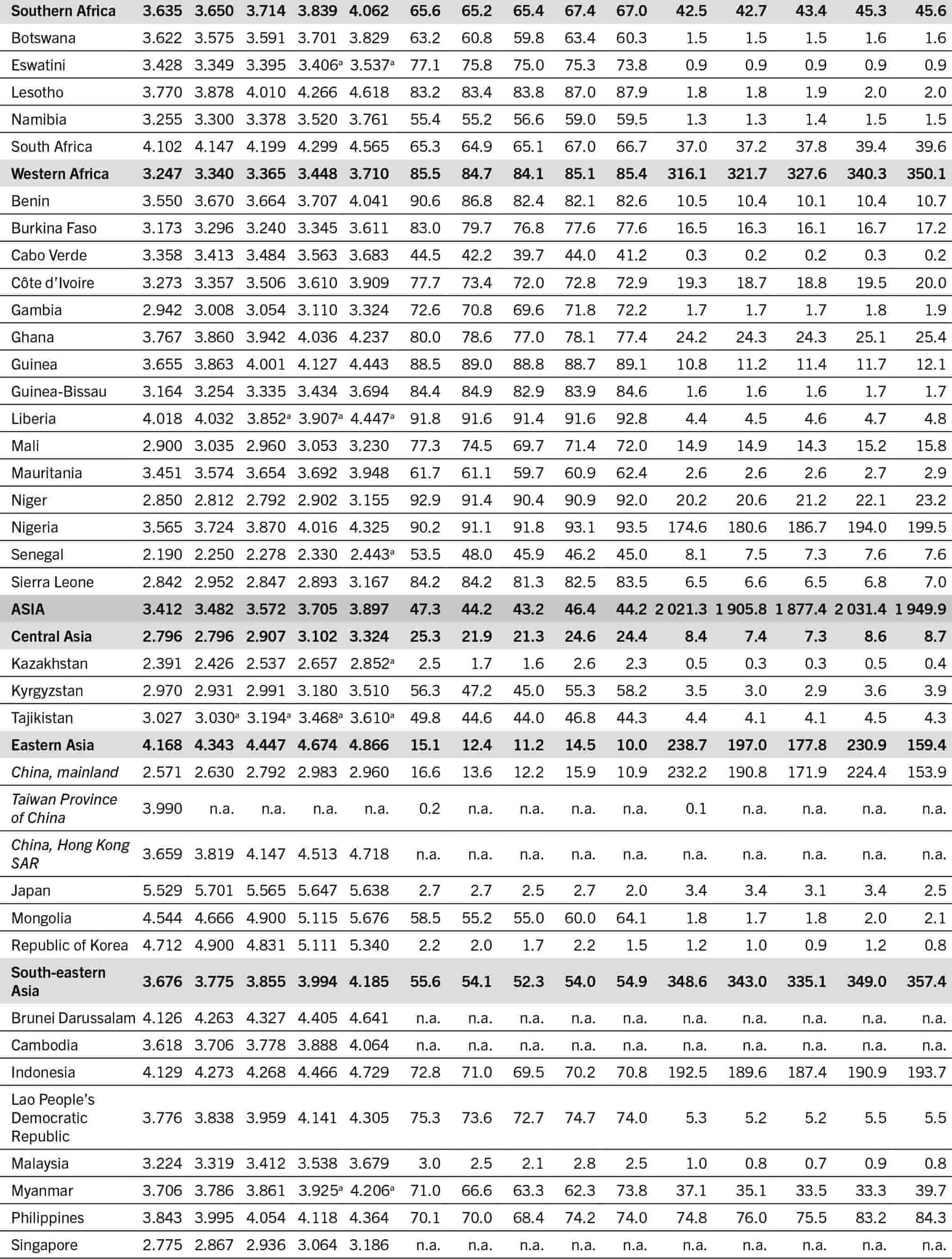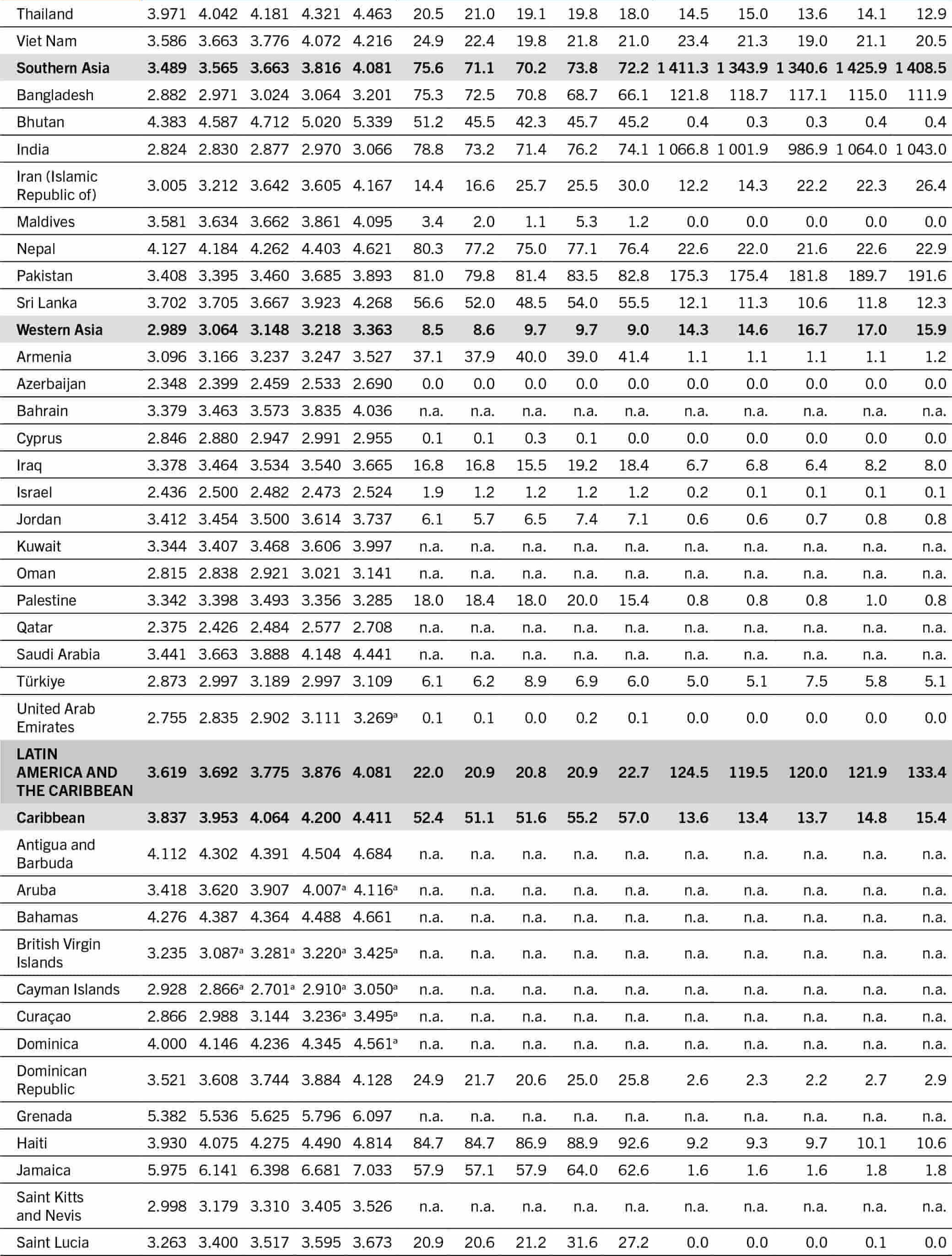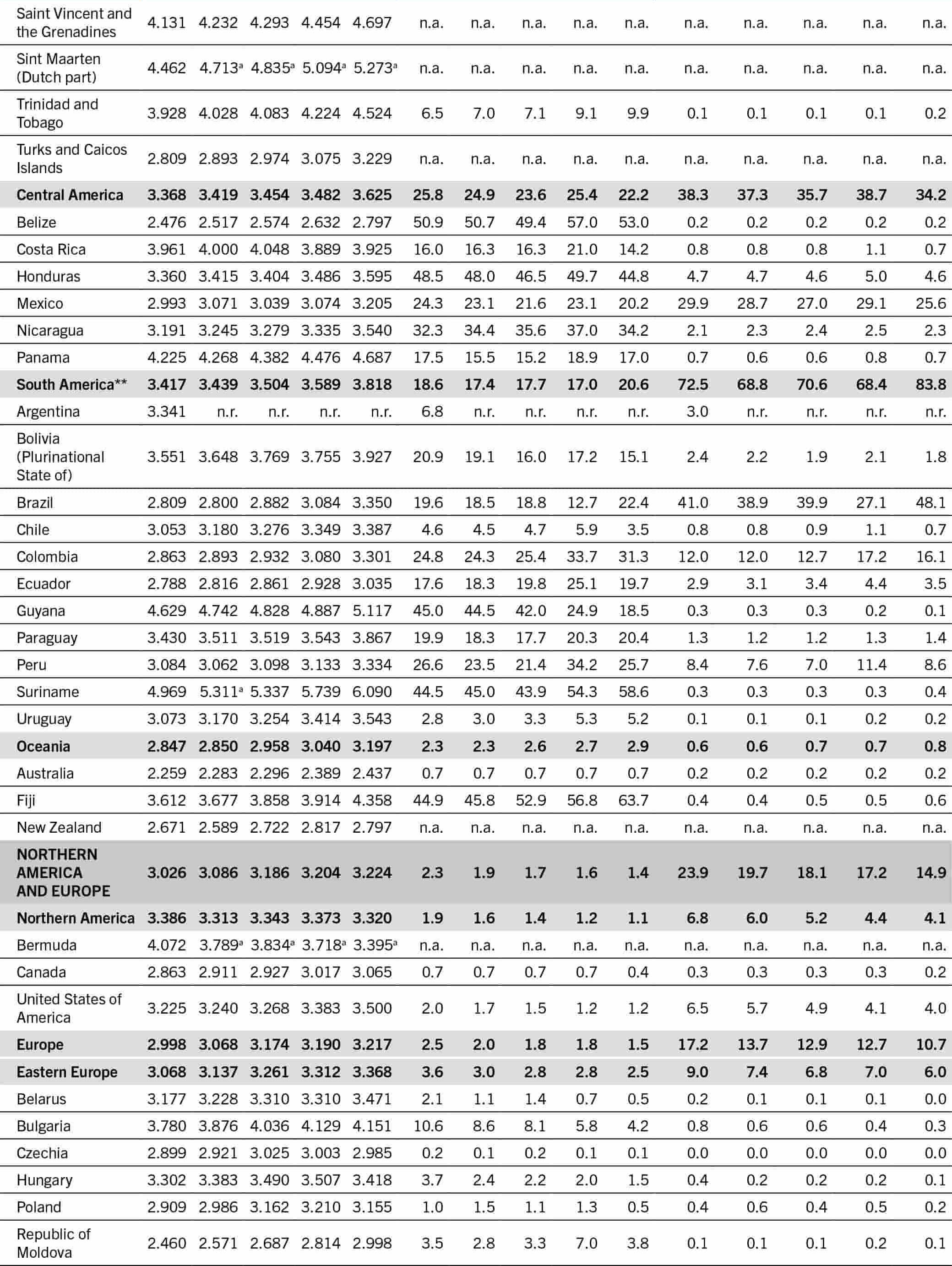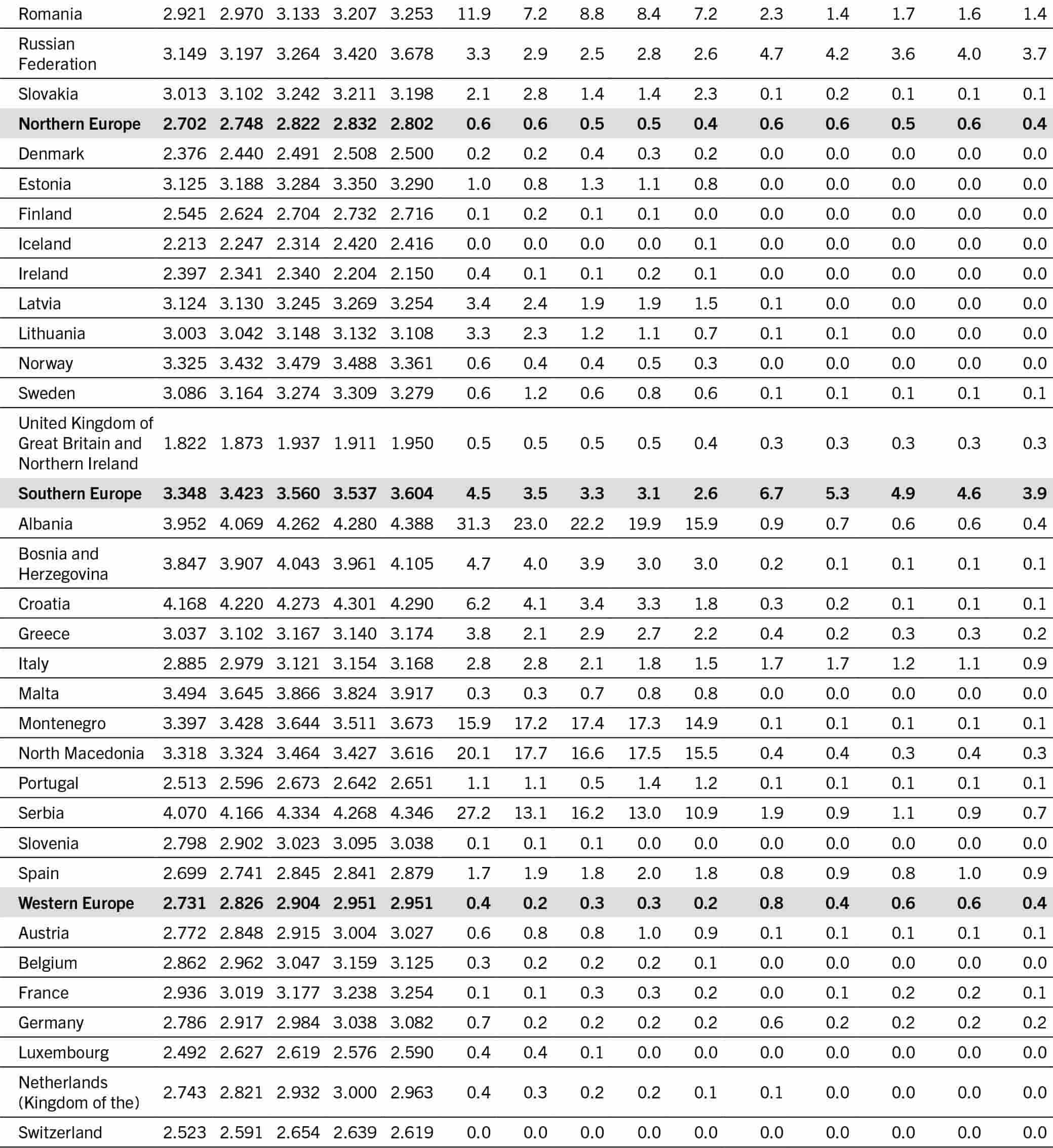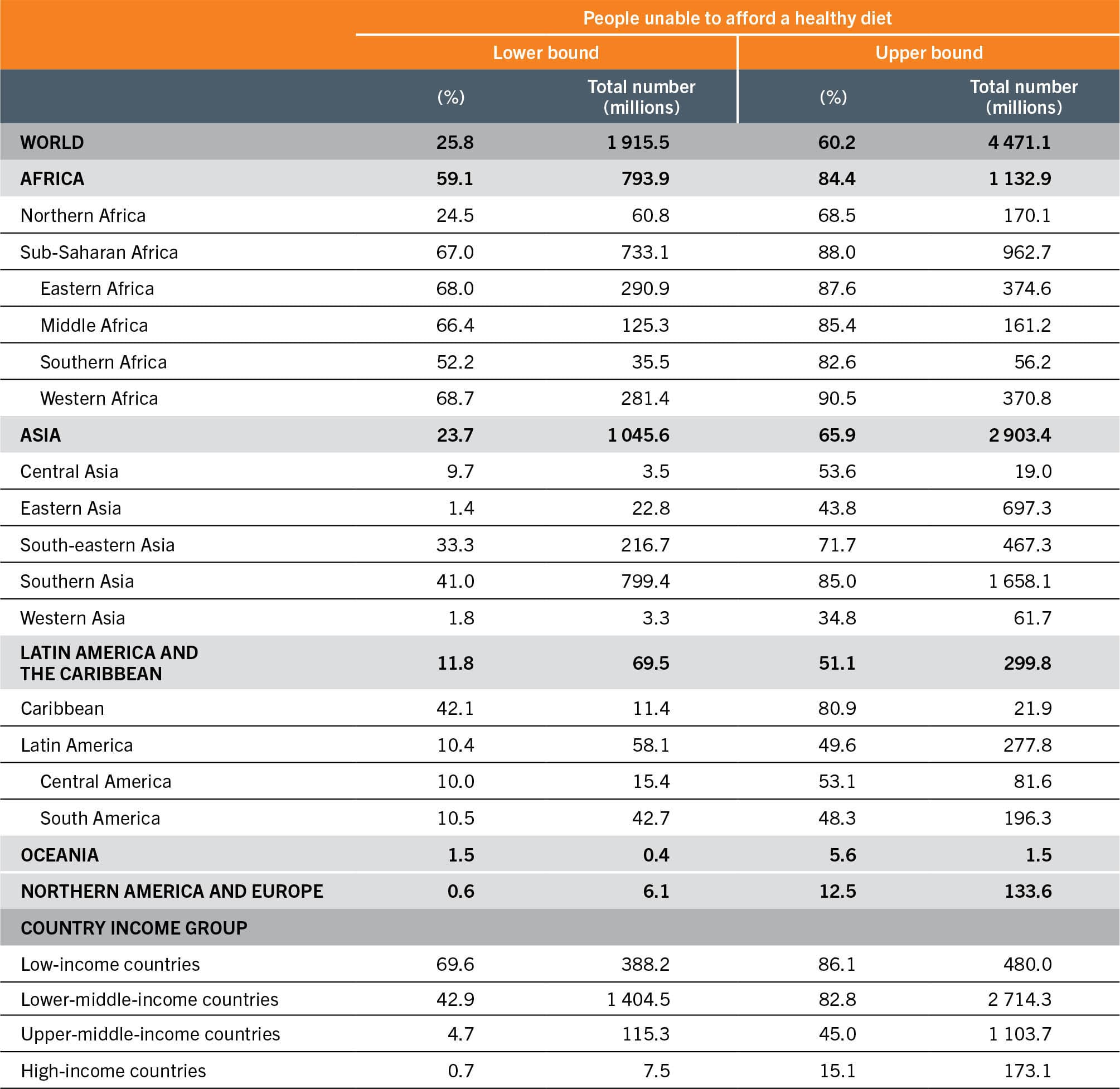Table A3-1: Long Description The data is represented as Regions/subregions/countries/ territories: Cost of a healthy diet 2017, 2018, 2019, 2020, 2021, People unable to afford a healthy diet in percent 2017, 2018, 2019, 2020, 2021, in millions 2017, 2018, 2019, 2020, 2021. s for the prevalence of moderate or severe food insecurity in the total population, 2012, 2016 values for the prevalence of wasting in children (less than 5 years), 2012, 2016 values for the prevalence of stunting in children (less than 5 years), 2012, 2016 values for the prevalence of overweight in children (less 5 years), 2012, 2016 values for the prevalence of obesity in the adult population (greater than or equal to 18 years), 2012, 2016 values for the prevalence of anemia in women(15 to 49 years), 2012, 2016 values for the prevalence of exclusive breastfeeding among infants (0 to 5 months), and 2012, 2016 values for the prevalence of low birthweight. World: 12, 9.2, 7.8, 11.3, 21.9, 29.5, 6.8, 26.3, 22.3, 5.5, 5.6, 11.8, 13.1, 28.5, 29.9, 37, 47.7, 15, and 14.7. Least developed countries: 25.3, 21.7, 19.8, 24.2, 50.4, 59.3, 7, 38.7, 32.3, 3.1, 3.2, 4.9, 6, 39.1, 39.4, 45.5, 53.5, 16.1, and 15.3. Landlocked developing countries: 24.6, 19.3, 16.4, 23, 44.8, 56.2, 4.1, 35.8, 28.3, 4.2, 3.7, 8.3, 9.4, 32, 32.9, 45.3, 53.3, 15.2, and 14.7. Small Island Developing States: 17.5, 15.3, 21.5, 20.4, 45.5, 46.8, 4.1, 21.3, 21.1, 6.8, 8, 18.8, 20.9, 28.2, 29.2, 37, 42.9, 14, and 14.4. Low-income countries: 26.9, 27.9, 22.5, 28, 55.6, 65.7, 6.6, 39.6, 33.5, 3.8, 3.4, 6, 6.9, 38.3, 38.5, 43, 53.3, 15.3, and 14.8. Lower-middle-income countries: 18.2, 13.5, 10.9, 16.2, 27.6, 39.6, 9.7, 35.5, 28.1, 4.3, 4.5, 7, 8.2, 41.7, 42.1, 39.9, 51.8, 20, and 18.5. Upper-middle-income countries: 6.9, less than 2.5, 3, 4.6, 12.7, 16.2, 1.7, 10.1, 8.3, 8, 8.8, 11.5, 13.2, 17.6, 18.1, 28.8, 35.8, 7.6, and 8.1. High-income countries: less than 2.5, less than 2.5, 1.5, 1.6, 8.3, 7.6, 0.4, 4, 4, 7.4, 7.6, 22.3, 24.3, 13.1, 14.4, not available, not available, 8, and 8.1. Low-income-food-deficit countries: 27, 24.9, 20.6, 26.1, 51.8, 62.7, not available, 36.8, 30.5, 4, 3.7, 7.1, 8.2, 37.8, 37.7, 41, 51.8, 14.6, and 14.
Table A3-1 (Continued): Long Description The data is represented as Regions/subregions/countries/ territories: Cost of a healthy diet 2017, 2018, 2019, 2020, 2021, People unable to afford a healthy diet in percent 2017, 2018, 2019, 2020, 2021, in millions 2017, 2018, 2019, 2020, 2021. s for the prevalence of moderate or severe food insecurity in the total population, 2012, 2016 values for the prevalence of wasting in children (less than 5 years), 2012, 2016 values for the prevalence of stunting in children (less than 5 years), 2012, 2016 values for the prevalence of overweight in children (less 5 years), 2012, 2016 values for the prevalence of obesity in the adult population (greater than or equal to 18 years), 2012, 2016 values for the prevalence of anemia in women(15 to 49 years), 2012, 2016 values for the prevalence of exclusive breastfeeding among infants (0 to 5 months), and 2012, 2016 values for the prevalence of low birthweight. Africa: 19.5, 19.3, 17.8, 23.4, 46.6, 58.9, 5.8, 34.4, 30, 5, 4.9, 11.5, 12.8, 39.2, 38.9, 35.4, 44.3, 14.5, and 13.9. Northern Africa: 6.1, 6.8, 9.8, 10.9, 28.6, 32.2, 6.3, 23.5, 21.7, 11.8, 12.3, 23, 25.2, 31.9, 31.1, 40.8, not available, 14, and 14.1. Algeria: 6.7, less than 2.5, 13, 5.6, 22.9, 19.4, 2.7, 12.1, 8.6, 13.5, 11.9, 24.7, 27.4, 32.9, 33.3, 25.4, 28.6, 6.9, and 7.2. Egypt: 6.4, 7.2, 8.4, 8.8, 27.8, 28.5, not available, 24.6, 20.4, 15.7, 18.8, 29.3, 32, 31, 28.3, 52.8, not available, not available, not available. Libya: 4.7, 8.4, 11.2, 21.2, 29.1, 39.8, not available, 30, 52.2, 26.4, 28.7, 30, 32.5, 28.6, 29.9, not available, not available, not available, not available. Morocco: 5.5, 6.3, not available, not available, not available, not available, 2.3, 15.8, 12.8, 9.5, 4.9, 23.4, 26.1, 29.8, 29.9, 27.8, 35, 16.1, and 14.8. Sudan: empty, 11.9, 13.4b, 18.1, 41.4, 51.8, not available, 36, 36, 2.4, 2.7, not available, not available, 36.8, 36.5, 41, not available, not available, not available. Tunisia: 4.3, 3, 9.1, 12.6, 18.2, 28.5, 2.1, 8.8, 8.6, 12.7, 19, 24.6, 26.9, 30.4, 32.1, 8.5, 13.5, 8.1, and 8.2. Northern Africa (excluding Sudan): 6.1, 5.7, 9.1, 9.3, 26.1, 28, not available, not available, not available, not available, not available, 26.8, 29.5, not available, not available, 40.7, not available, not available, not available. Sub-Saharan Africa: 22.9, 22.1, 19.6, 26.2, 50.8, 64.9, 5.7, 36.2, 31.3, 3.8, 3.7, 8, 9.2, 41.2, 40.7, 34.4, 45.1, 14.5, and 13.9. Eastern Africa: not available, not available, not available, not available, not available, not available, 4.9, 56.5, 56.5, 2.2, 3.6, 4.4, 5.4, 31.1, 38.5, 69.3, 71.9, 15.1, and 14.8. Burundi: 16.8, 13.5, not available, 27.4, not available, 79.7, not available, 31.9, 18.8, 11.5, 7.7, 6.7, 7.8, 32.8, 33.8, 11.4, not available, 24.1, and 23. Comoros: 30.2, 16.8, not available, 16.5, not available, 49.2, 10.6, 29.6, 18.7, 1.3, 3.2, 12.3, 13.5, 31, 32.3, 12.4, not available, not available, not available. Djibouti: not available, not available, not available, not available, not available, not available, not available, 51.6, 50.2, 1.9, 3, 4.1, 5, 36.2, 37, 68.7, not available, 15.4, and 15.2. Eritrea: 37.1, 21.9, 14.5, 21.1, 56.2, 58.1, 6.8, 42.1, 34.4, 2.5, 2.7, 3.6, 4.5, 22.4, 23.9, 52, 58.8, not available, not available. Ethiopia: 28.4, 27.8, 15, 28, 50.7, 72.3, 4.9, 28.6, 18.4, 4.6, 3.8, 5.9, 7.1, 28.4, 28.7, 31.9, not available, 10.8, and 10. Kenya: 33.7, 51, not available, 12.2, not available, 64.9, 7.2, 47.3, 38.6, 1.8, 1.5, 4.3, 5.3, 37.5, 37.8, 41.9, 54.4, 19.5, and 18.7. Madagascar: 21.9, 17.8, 47.7, 52.2, 78.1, 82.4, 2.6, 43.6, 34, 4.9, 3.9, 4.8, 5.8, 30.6, 31.4, 70.8, 64.1, 15.8, and 15.6. Malawi: 5.1, 6.8, 5.2, 10.5, 13, 32, not available, 9, 8.6, 7.8, 6.8, 9.6, 10.8, 19.2, 23.5, not available, not available, 19.1, and 18.7. Mauritius: 33.8, 30.5, not available, 39.6, not available, 75.4, 3.9, 42.6, 36.4, 5.5, 5.5, 6.1, 7.2, 48.8, 47.9, 40, not available, 18.1, and 17.8.
Table A3-1 (Continued1): Long Description The data is represented as Regions/subregions/countries/ territories: Cost of a healthy diet 2017, 2018, 2019, 2020, 2021, People unable to afford a healthy diet in percent 2017, 2018, 2019, 2020, 2021, in millions 2017, 2018, 2019, 2020, 2021. s for the prevalence of moderate or severe food insecurity in the total population, 2012, 2016 values for the prevalence of wasting in children (less than 5 years), 2012, 2016 values for the prevalence of stunting in children (less than 5 years), 2012, 2016 values for the prevalence of overweight in children (less 5 years), 2012, 2016 values for the prevalence of obesity in the adult population (greater than or equal to 18 years), 2012, 2016 values for the prevalence of anemia in women(15 to 49 years), 2012, 2016 values for the prevalence of exclusive breastfeeding among infants (0 to 5 months), and 2012, 2016 values for the prevalence of low birthweight. Rwanda: 34.3, 31.6, not available, not available, not available, not available, 1.1, 41.2, 29.8, 6.3, 4.7, 4.7, 5.8, 18.3, 17.2, 83.8, 80.9, 9.3, and 9.4. Seychelles: 2.6, 4.3, 3.2, 3.3, 14.3, 14.7, not available, 7.9, 7.2, 9.9, 9.1, 12.4, 14, 23.5, 25.1, not available, not available, 12.3, and 12.5. Somalia: 70.4, 48.7, not available, 43.4, not available, 79.5, not available, 27.6, 18, 3, 2.7, 7, 8.3, 44, 43.1, 5.3, 33.7, not available, not available. South Sudan: empty, 21.4, not available, 63.2, not available, 87.3, not available, 30.8, 27.9, 6.3, 4.7, not available, not available, 34.7, 35.6, 44.5, not available, not available, not available. Uganda: 16.9, 31.6, 21.5, 24.9, 66.3, 74.2, 3.6, 33.3, 23.4, 3.9, 3.5, 4.3, 5.3, 31.3, 32.8, 62.2, 65.5, not available, not available. United Republic of Tanzania: 28.1, 23.5, 20.6, 26.3, 48.9c, 58.7, 3.3, 38.1, 30.6, 4.5, 4.6, 6.9, 8.4, 40.3, 38.9, 48.7, 57.8, 10.5, and 9.7. Zambia: 51.4, 29.8, 22.4, 32.1, 51.2, 73.1, 4.2, 40.8, 31.4, 6, 5.4, 6.8, 8.1, 30.5, 31.5, 59.9, 69.9, 12, and 11.2. Zimbabwe: 30, 38.4, 35.5, 28.6, 64.7, 73.6, 2.9, 31.1, 21.6, 4.6, 2.7, 14.3, 15.5, 30, 28.9, 31.3, 41.9, 12.2, and 11.8. Middle Africa: 31.9, 28.4, not available, 37.7, not available, 74.7, 5.6, 37.9, 37.4, 4.5, 4.6, 6.7, 7.9, 46.1, 43.2, 28.4, 44.4, 12.8, and 12.2. Angola: 52.6, 21.6, 21, 31.2, 66.5, 78.5, not available, 31.8, 43.6, 3, 3.9, 6.8, 8.2, 45.9, 44.5, not available, 37.4, 15.7, and 15.5. Cameroon: 15.8, 6.4, 22.3, 26.7, 49.9, 58.5, 4.3, 32.1, 26.9, 7.1, 10.5, 9.8, 11.4, 41.2, 40.6, 19.9, 39.4, 12.9, and 12.5. Central African Republic: 38.9, 48.7, not available, 61.8, not available, 81.3, 5.4, 40.6, 39.8, 3.5, 2.6, 6.4, 7.5, 47.9, 46.8, 33, 36.2, 15.9, and 16.4. Chad: 38.1, 31.4, not available, not available, not available, not available, 8.3, 38.9, 32.3, 2.5, 3.2, 5.1, 6.1, 49.2, 45.4, 3.2, 16.2, not available, not available. Congo: 34.5, 33.3, 42.6, 58.8, 82, 88.2, not available, 23.1, 16.5, 5.1, 4.5, 8.3, 9.6, 53.1, 48.8, 20.2, not available, 11.6, and 11.9. Democratic Republic of the Congo: 28.4, 35.3, not available, 40.7, not available, 76.6, 6.4, 42.7, 40.3, 4.6, 3.7, 5.6, 6.7, 46.4, 42.4, 36.4, 53.6, 11, and 10.2. Equatorial Guinea: not available, not available, not available, not available, not available, not available, not available, 25, 16.1, 8.5, 8.2, 6.8, 8, 47.4, 44.5, 7.4, not available, not available, not available. Gabon: 14.4, 23, not available, not available, not available, not available, 3.4, 17.2, 13.4, 6.2, 5.4, 13.5, 15, 55.3, 52.4, 5.1, not available, 14.9, and 14.6. Sao Tome and Principe: 10.3, 13.1, not available, 14.1, not available, 54.6, 4.1, 18.8, 10, 2.5, 4.7, 10.7, 12.4, 45.7, 44.2, 50.3, 63.1, 10.6, and 11.1.
Table A3-1 (Continued2): Long Description The data is represented as Regions/subregions/countries/ territories: Cost of a healthy diet 2017, 2018, 2019, 2020, 2021, People unable to afford a healthy diet in percent 2017, 2018, 2019, 2020, 2021, in millions 2017, 2018, 2019, 2020, 2021. s for the prevalence of moderate or severe food insecurity in the total population, 2012, 2016 values for the prevalence of wasting in children (less than 5 years), 2012, 2016 values for the prevalence of stunting in children (less than 5 years), 2012, 2016 values for the prevalence of overweight in children (less 5 years), 2012, 2016 values for the prevalence of obesity in the adult population (greater than or equal to 18 years), 2012, 2016 values for the prevalence of anemia in women(15 to 49 years), 2012, 2016 values for the prevalence of exclusive breastfeeding among infants (0 to 5 months), and 2012, 2016 values for the prevalence of low birthweight. Botswana: 22.9, 22.9, 18.4, 26.7, 46.5, 56.3, not available, 24.6, 21.6, 10.4, 10.1, 17.5, 18.9, 31.3, 32.5, 20.3, 30, 17.3, and 16.8. Eswatini: 9.6, 11.6, not available, 18.3, not available, 67, not available, 28, 21.2, 10.1, 7.9, 14.9, 16.5, 30, 30.7, 43.8, not available, 10.6, and 10.2. Lesotho: 13.9, 46, not available, 32.9, not available, 56.7, 2.1, 37.5, 31.8, 7, 6.9, 14.9, 16.6, 28.3, 27.9, 52.9, 59, 14.8, and 14.4. Namibia: 20.3, 17.1, 28.8, 33, 53.2, 57.7, not available, 24, 16.8, 4.2, 5.3, 15.1, 17.2, 24.7, 25.2, 22.1, not available, 15.9, and 15.6. South Africa: 3.4, 7.9, not available, 9, not available, 20.3, 3.8, 22.5, 22.8, 13.1, 12.1, 26.1, 28.3, 28.6, 30.5, not available, 31.6, 16.6, and 16.6. Benin: 12, 9.9, 10.4, 15.3, 55, 73.6, 5, 33.9, 30.4, 1.6, 2.2, 8.2, 9.6, 55.5, 55.2, 32.5, 41.4, 17.5, and 16.4. Burkina Faso: 17.8, 16.2, 10, 21.2, 41.8, 56.9, 10.6, 33.3, 21.8, 1.8, 2, 4.5, 5.6, 53.3, 52.5, 38.2, 57.9, 19.1, and 18.5. Cabo Verde: 11.2, 18.2, not available, 6.3, not available, 37, not available, 12.6, 9.4, not available, not available, 10.3, 11.8, 26.9, 24.3, 59.6, 41.8, not available, and not available. Côte d'Ivoire: 16.9, 7.7, 6.2, 9.7, 34.1, 44.2, 8.4, 29.6, 20.2, 2.6, 2.6, 8.7, 10.3, 52.2, 50.9, 11.8, 34, 19.1, and 18.3. Gambia: 21.5, 19.6, not available, 27, not available, 60.7, 5.1, 22.3, 13.6, 1.9, 1.8, 8.7, 10.3, 56.4, 49.5, 33.2, 53.6, 13.7, and 13.2. Ghana: 11.1, 4.9, 5.1, 6.2, 38.3, 39.4, 6.8, 22, 12.7, 2.3, 1.9, 9.4, 10.9, 44.2, 35.4, 45.7, 42.9, 14.9, and 14.4. Guinea: 14.9, 12.9, 44.3, 49.5, 72.5, 73.1, 9.2, 33.7, 27.9, 4.4, 5.6, 6.4, 7.7, 50.9, 48, 20.4, 33.4, not available, and not available. Guinea-Bissau: 16.4, 37.9, not available, 32, not available, 77.8, 5.1, 29.3, 27.7, 2.8, 3.3, 7.9, 9.5, 49.9, 48.1, 38.3, 59.3, 21.8, and 19.5. Liberia: 33.5, 38.4, 38.6, 37.5, 79.7, 81.2, 3.4, 35, 26.6, 3.3, 5.3, 8.6, 9.9, 43.6, 42.6, 27.8, 55.2, 19.7, and 19.9. Mali: 13.6, 12.8, not available, not available, not available, not available, 10.6, 30.7, 23.8, 1.6, 2, 7.2, 8.6, 58.2, 59, 20.2, 47.7, not available, and not available. Mauritania: 9.1, 8.7, 4.6, 9.5, 26.3, 53.7, 13.6, 26, 22.1, 1.9, 2, 11, 12.7, 45.1, 43.3, 26.7, 40.9, not available, and not available. Niger: 19.1, 16.1, not available, 30.5, not available, 71.4, 10.9, 46.6, 47.4, 1.1, 2.7, 4.5, 5.5, 49.1, 49.5, 23.3, 25.6, not available, and not available. Nigeria: 7, 15.9, 11, 21.3, 34.7, 69.7, 6.5, 37.7, 34.2, 2.5, 2.2, 7.4, 8.9, 54.9, 55.1, 14.7, 28.7, not available, and not available. Senegal: 18.1, 5.7, 7.5, 11.1, 39, 49.8, 8.1, 18.5, 17, 1.5, 3.4, 7.6, 8.8, 55.9, 52.7, 39, 40.8, 19.1, and 17.2. Sierra Leone: 46.5, 27.8, 26.7, 31.9, 75.8, 89.2, 6.3, 34.9, 26, 3.3, 5.2, 7.4, 8.7, 47.9, 48.4, 31.2, 50.9, 11.4, and 10.3. Togo: 28.3, 17.4, 16.1, 19.4, 60.4, 62.9, 5.7, 27.3, 22.3, 1.6, 2.2, 7.1, 8.4, 47.4, 45.7, 62.1, 64.3, 15.1, and 14.3.
Table A3-1 (Continued3): Long Description The data is represented as Regions/subregions/countries/ territories: Cost of a healthy diet 2017, 2018, 2019, 2020, 2021, People unable to afford a healthy diet in percent 2017, 2018, 2019, 2020, 2021, in millions 2017, 2018, 2019, 2020, 2021. s for the prevalence of moderate or severe food insecurity in the total population, 2012, 2016 values for the prevalence of wasting in children (less than 5 years), 2012, 2016 values for the prevalence of stunting in children (less than 5 years), 2012, 2016 values for the prevalence of overweight in children (less 5 years), 2012, 2016 values for the prevalence of obesity in the adult population (greater than or equal to 18 years), 2012, 2016 values for the prevalence of anemia in women(15 to 49 years), 2012, 2016 values for the prevalence of exclusive breastfeeding among infants (0 to 5 months), and 2012, 2016 values for the prevalence of low birthweight. Sub-Saharan Africa (including Sudan): 22, 21.7, 19.4, 25.9, 50.5, 64.4, not available, not available, not available, not available, not available, 7.7, 8.9, not available, not available, 34.6, 45.1, not available, and not available. Asia: 13.6, 8.6, 6.7, 9.9, 17.7, 24.8, 9.3, 28.2, 22.3, 4.8, 5.1, 6.1, 7.3, 31.1, 32.7, 39, 51.5, 17.2, and 17.2. Central Asia: 14, 3.2, 1.7, 4.8, 9.2, 18.4, 2.1, 14.7, 7.7, 8.2, 5, 15.6, 17.7, 28.8, 28.1, 29.2, 44.9, 6.3, and 6. Kazakhstan: 7.2, less than 2.5, not available, 0.5, not available, 2.4, not available, 11, 4.9, 12.1, 7.7, 19, 21, 27.3, 28.7, 31.8, 37.8, 5.7, and 5.3. Kyrgyzstan: 8, 4.8, not available, 1.1, not available, 6.9, 2, 16, 10.3, 7.9, 6.4, 14.4, 16.6, 34.1, 35.8, 56, 45.6, 6.4, and 6. Tajikistan: 37.6, 9.3, not available, not available, not available, not available, 5.6, 25.7, 13.1, 5.4, 3, 12.2, 14.2, 31, 35.2, 32.6, 35.8, 9.3, and 8.7. Turkmenistan: 4.2, 5.7, not available, not available, not available, not available, 4.1, 12.5, 6.7, 5.4, 3.6, 16.3, 18.6, 25.3, 26.6, 10.9, 56.5, 4.9, and 4.3. Uzbekistan: 14.8, less than 2.5, 1.9, 6.8, 11.2, 26.1, 2.4, 13.2, 6.9, 7.7, 4.2, 14.4, 16.6, 28.7, 24.8, 23.8, 49.5, 5.8, and 5.8. Eastern Asia: 6.9, less than 2.5, 1, 1.3, 6, 6.7, 1.5, 7.7, 4.9, 6.6, 8.3, 4.9, 6, 15.5, 16.1, 28.4, 35.3, 5.5, and 5.5. China: 7, less than 2.5, not available, not available, not available, not available, 1.9, 7.6, 4.6, 7, 8.9, 5, 6.2, 14.8, 15.5, 27.6, 34.1, 5.1, and 5. China, mainland: 7.1, less than 2.5, not available, not available, not available, not available, not available, not available, not available, not available, not available, not available, not available, not available, not available, not available, not available, and not available. Taiwan Province of China: 4.3, 3, not available, not available, not available, not available, not available, not available, not available, not available, not available, not available, not available, 27, 28.4, not available, not available, not available, and not available. China, Hong Kong SAR: less than 2.5, less than 2.5, not available, not available, not available, not available, not available, not available, not available, not available, not available, not available, not available, not available, not available, not available, not available, and not available. China, Macao SAR: 15.9, 8, not available, not available, not available, not available, not available, not available, not available, not available, not available, not available, not available, not available, not available, not available, not available, and not available. Democratic People’s Republic of Korea: 34.3, 45.5, not available, not available, not available, not available, 2.5, 25.7, 16.8, 1.6, 2.8, 5.9, 6.8, 31.7, 33.9, 68.9, 71.4, not available, and not available. Japan: less than 2.5, 3.2, less than 0.5, 0.9, 2.6, 4.4, not available, 6.5, 5, 1.7, 2.1, 3.6, 4.3, 19.7, 19, not available, not available, 11.1, and 11.3. Mongolia: 28.8, 8, less than 0.5, less than 0.5, 6.8, 5.7, 0.9, 12.2, 6.1, 9.8, 10.7, 17.9, 20.6, 14.3, 14.5, 65.7, 58, 5.7, and 4.9. Republic of Korea: less than 2.5, less than 2.5, less than 0.5, 0.8, 4.8, 5.6, 0.2, 1.9, 1.7, 6.8, 5.4, 4.1, 4.7, 13.7, 13.5, not available, not available, 6.3, and 7.5.
NOTES: The table shows the cost and affordability of a healthy diet at the country level, as well as by region, subregion, and country income group in 2017–2021. For each region, subregion and country income group, the unaffordability estimated as the percentage of the population unable to afford a healthy diet is population weighted. The 2022 World Bank classification of countries by income group is used for all years from 2017 to 2021 and for all countries and territories except Anguilla and Montserrat, for which income classification is not provided. n.a. = data not available. n.r. = data not reported because of insufficient or unreliable data to update cost and affordability. * Cost and affordability of a healthy diet include Zimbabwe. ** Cost and affordability of a healthy diet include Argentina.
a PPP was imputed in this year.
SOURCE: FAO. 2023. FAOSTAT: Cost and Affordability of a Healthy Diet (CoAHD). In:
FAO . [Cited 12 July 2023].
www.fao.org/faostat/en/#data/CAHD 
